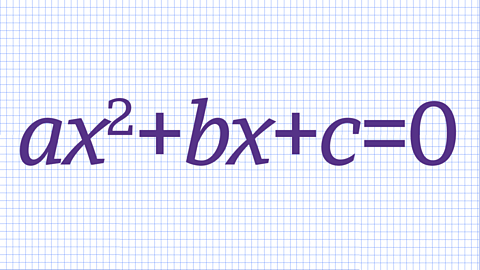Algebraic fractions
An algebraic fraction is a fraction with algebraic terms in the numerator or the denominator or both.
Examples
\(\dfrac{3}{x}\)
\(\dfrac{x + 3}{x - 1}\)
\(\dfrac{12x}{5}\)
\(\dfrac{9x^2 - 1}{3x^2 - 2x - 1}\)
These topics are very useful
Adding/subtracting algebraic fractions
The same method is used for adding and subtracting numerical fractions or algebraic fractions.
- Find a common denominator
- Write each fraction as an equivalent fraction with that common denominator
- Add/subtract the numerators of these equivalent fractions and keep the common denominator
Example
Simplify
\(\dfrac{3}{2m} + \dfrac{1}{3m}\)
Solution
Find a common denominator
The common denominator of \(2m\) and \(3m\) is \(\mathbf {6m}\)
Write each fraction as an equivalent fraction with that common denominator
\(\dfrac{3}{2m} = \dfrac{9}{6m}\quad and \quad\dfrac{1}{3m} = \dfrac{2}{6m}\)
it may help to look at the equation like this \(\color{purple}\dfrac{3}{2m} = \dfrac{9}{6m}\quad \text{and} \quad\dfrac{1}{3} = \dfrac{2}{6}\)
Answer:
Add the numerators of these equivalent fractions and keep the common denominator
\(\dfrac{9}{6m} + \frac{2}{6m} = \dfrac{11}{6m}\)
Answer
\(\mathbf {\dfrac{11}{6m}}\)
Question
Simplify
\(\dfrac{2}{5c} + \dfrac{7}{3c}\)
Solution:
Find a common denominator
The common denominator of \(5c\) and \(3c\) is \(\mathbf{15c}\)
Write each fraction as an equivalent fraction with that common denominator
\(\dfrac{2}{5c} + \dfrac{7}{3c} = \dfrac{6}{15c} + \dfrac{35}{15c}\)
it may help to look at the equation like this \(\color{purple}\dfrac{2}{5} + \dfrac{7}{3} = \dfrac{6}{15} + \dfrac{35}{15}\)
Answer:
Add the numerators of these equivalent fractions and keep the common denominator
\(\dfrac{6}{15c} + \dfrac{35}{15c} = \dfrac{41}{15c}\)
Answer
\(\mathbf {\dfrac{41}{15c}}\)
Example
Simplify
\(\dfrac{4}{x + 1} + \dfrac{3}{x - 5}\)
Solution
This example looks difficult because of the more complex terms in the denominator, but the method is just the same.
An extra final step will be needed to simplify the numerator.
Find a common denominator
The common denominator of \(x+1\) and \(x-5\) is \((x+1)(x-5)\)
When the terms in the denominator are not 'like terms', their product is the common denominator
Write each fraction as an equivalent fraction with that common denominator
\(\dfrac{4}{x + 1} = \dfrac{7}{3c} = \dfrac{4(x+5)}{(x+1)(x-5)}\) and
\(\dfrac{3}{x-5} = \dfrac{3(x+1)}{(x+1)(x-5)}\)
Add the numerators of these equivalent fractions and keep the common denominator
\(\dfrac{4(x-5)}{(x+1)(x-5)} + \dfrac{3(x+1)}{(x+1)(x-5)} = \dfrac{4(x-5) + 3(x +1)}{(x+1)(x-5)}\)
Answer:
Simplify the numerator
\(= \dfrac{4x -20 +3x + 3}{(x+1)(x-5)}\)
\(= \dfrac{7x -17}{(x+1)(x-5)}\)
Answer \(= \dfrac{7x -17}{(x+1)(x-5)}\)
Question
Write as a single fraction
\(\dfrac{1}{2x + 3} - \dfrac{4}{x -2}\)
Solution:
Find a common denominator
The common denominator of \(2x + 3\) and \(x - 2\) is \((2x + 3)(x - 2)\)
When the terms in the denominator are not 'like terms', their product is the common denominator.
Write each fraction as an equivalent fraction with that common denominator
\(\dfrac{1}{2x+3} = \dfrac{x-2}{(2x+3)(x-2)}\) and \(\dfrac{4}{x-2} = \dfrac{4(2x+3)}{(2x+3)(x-2)}\)
Subtract the numerators of these equivalent fractions and keep the common denominator
\(\dfrac{x-2}{(2x+3)(x-2)} - \dfrac{4(2x+3)}{(2x+3)(x-2)} = \dfrac{(x-2)-4(2x+3)}{(2x+3)(x-2)}\)
Simplify the numerator
\(\dfrac{(x-2)-4(2x+3)}{(2x+3)(x-2)} = \dfrac{-2-8x-12}{(2x+3)(x-2)}\) \(= \dfrac{-7x-14}{(2x+3)(x-2)}\)
Answer:
\(\dfrac{-7x-14}{(2x+3)(x-2)}\)
Test yourself
More on M4: Algebra
Find out more by working through a topic
- count2 of 4
